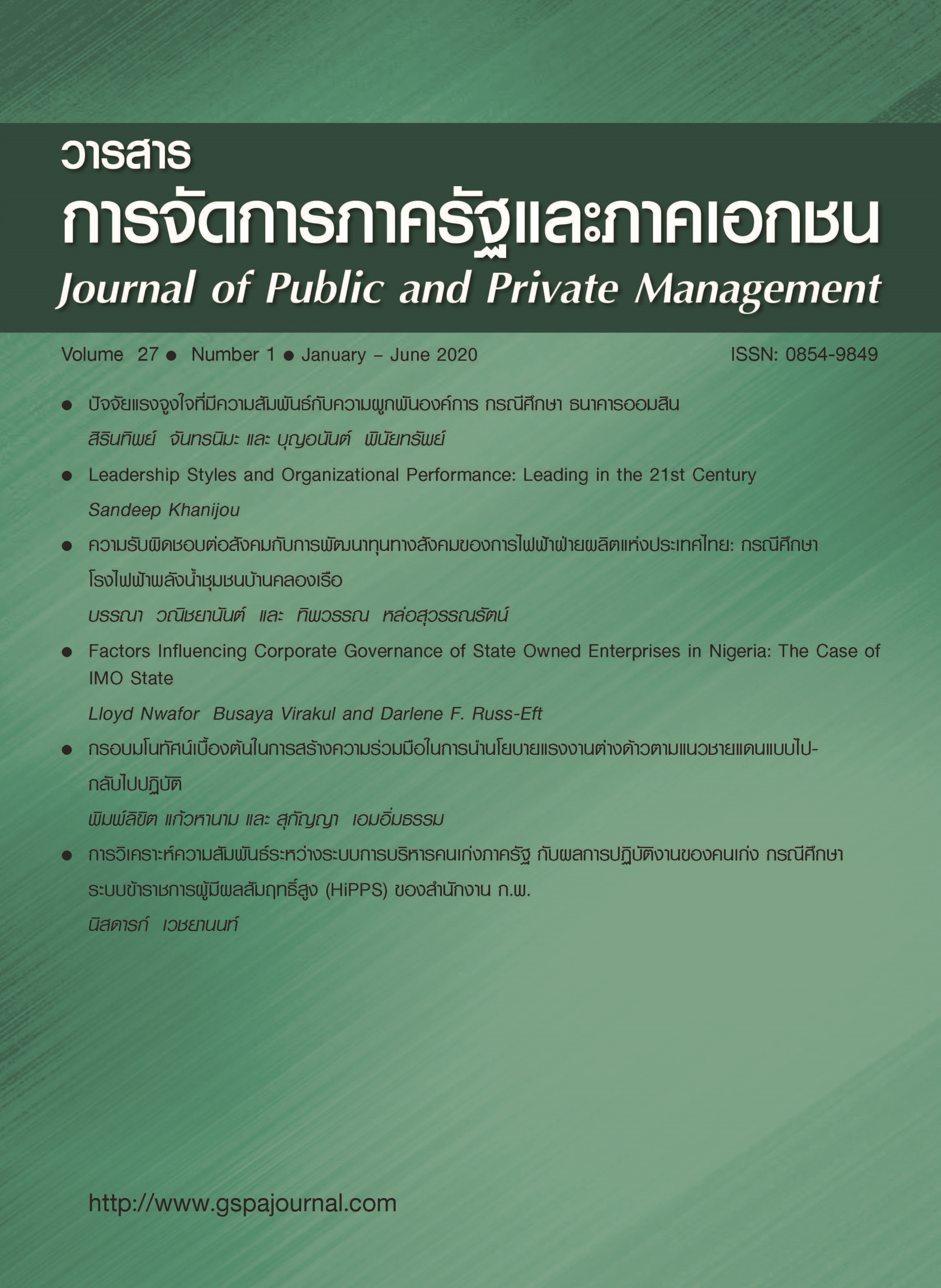ปัจจัยแรงจูงใจที่มีความสัมพันธ์กับความผูกพันองค์การ กรณีศึกษา ธนาคารออมสิน
Keywords:
ปัจจัยแรงจูงใจ, ความผูกพันองค์การ, ธนาคารออมสิน, Motivation Factors, Organization Commitment, Government Saving BankAbstract
ปัจจัยแรงจูงใจที่มีความสัมพันธ์กับความผูกพันองค์การ กรณีศึกษา ธนาคารออมสิน
การวิจัยครั้งนี้ มีวัตถุประสงค์ เพื่อศึกษาระดับความผูกพันองค์การ เพื่อเปรียบเทียบความผูกพันต่อองค์การ จำแนกตามปัจจัยส่วนบุคคล และศึกษาปัจจัยแรงจูงใจ ด้านความสำเร็จในงาน ด้านลักษณะของงาน ด้านความรับผิดชอบต่องานที่ได้รับมอบหมาย ด้านความก้าวหน้า ด้านการได้รับการยกย่อง ด้านการเลื่อนตำแหน่ง ด้านเงินเดือน ด้านความมั่นคงในงาน ด้านสถานะของบุคคล ด้านสภาพแวดล้อมในการทำงาน ด้านนโยบายขององค์การ ด้านความสัมพันธ์ระหว่างเพื่อนร่วมงาน ด้านการควบคุมดูแล ที่มีความสัมพันธ์กับความผูกพันองค์การ ซึ่งเป็นการวิจัยเชิงปริมาณเก็บรวบรวมข้อมูลโดยใช้แบบสอบถาม จำนวน 189 ชุด สถิติที่ใช้ในการวิเคราะห์ข้อมูล ได้แก่ การแจกแจงความถี่ ร้อยละ ค่าเฉลี่ย ส่วนเบี่ยงเบนมาตรฐาน การวิเคราะห์ t-test การวิเคราะห์ความแปรปรวนทางเดียว (One-Way ANOVA) และการวิเคราะห์ค่าสัมประสิทธิ์สหสัมพันธ์เพียร์สัน ผลการศึกษา พบว่า พนักงานสินเชื่อธุรกิจ SMEs ธนาคารออมสินที่มีปัจจัยด้านเพศ อายุ สถานภาพ รายได้ ตำแหน่งงาน และระยะเวลาที่ปฏิบัติงานด้านสินเชื่อกับธนาคาร ออมสินที่แตกต่างกัน มีความผูกพันองค์การแตกต่างกันอย่างมีนัยสำคัญทางสถิติที่ระดับ 0.05 และปัจจัยแรงจูงใจที่มีความสัมพันธ์ต่อความผูกพันองค์การของพนักงานสินเชื่อธุรกิจ SMEs ธนาคารออมสิน ได้แก่ ปัจจัยแรงจูงใจด้านความสำเร็จในงาน ด้านลักษณะของงาน ด้านความรับผิดชอบต่องานที่ได้รับมอบหมาย ด้านความก้าวหน้า ด้านการได้รับการยกย่อง ด้านการเลื่อนตำแหน่ง ด้านเงินเดือน ด้านความมั่นคงในงาน ด้านสถานะของบุคคล ด้านสภาพแวดล้อมในการทำงาน ด้านนโยบายขององค์การ ด้านความสัมพันธ์ระหว่างเพื่อนร่วมงาน ด้านการควบคุมดูแล โดยพบว่า ทุกปัจจัยข้างต้นมีความสัมพันธ์เชิงบวกต่อความผูกพันองค์การ ที่ระดับนัยสำคัญทางสถิติ 0.01
Motivation Factors Related to the Organizational Commitment: A Case Study of Government Savings Bank
This research aims to study the level of commitment of Government Savings Bank, to compare the commitment classified by personal factors and to study motivation factors including achievement, work itself, responsibility, growth, recognition for achievement, advancement, salary, security, status, working conditions, company policy and administration, interpersonal relations, and supervision related to the commitment. This is a quantitative methodology. The researchers had distributed 189 survey questionnaires. The statistical analysis consists of statistical analysis such as frequency distribution, percentage, arithmetic mean, standard deviation, t test, One-Way ANOVA, and Pearson’s Correlation Coefficient. The study reveals gender, age, status, salary, position level and the period of time working in organization affected the commitment to the organization at significant level of 0.05. Furthermore, the motivation factors related to the commitment of Government Savings Bank included achievement,work itself, responsibility, growth, recognition for achievement, advancement, salary, security, status, working conditions, company policy and administration, interpersonal relations, and supervision showed a positive correlation at significant level of 0.01.



